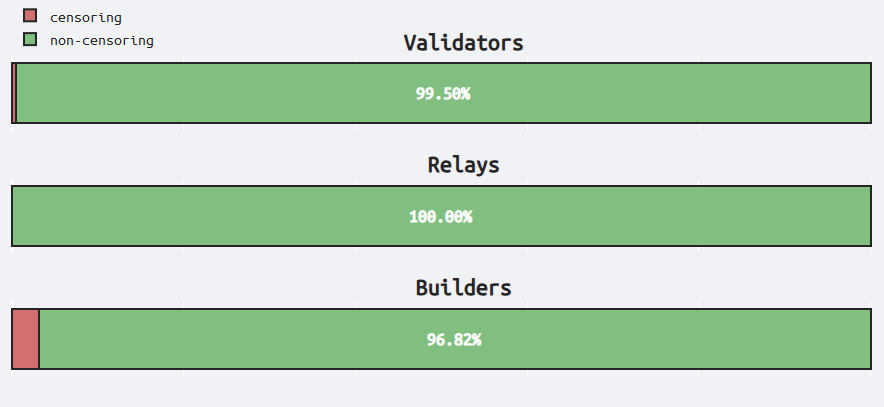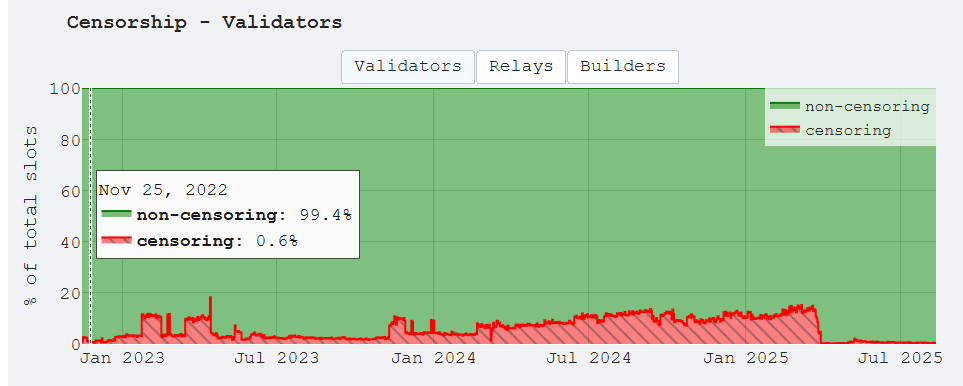The Cash Tornado case promoted technical implementations in Ethereum against censorship.
In March 2025, validators excluded 14% of operations.
As of August 13, the Ethereum Network records censorship levels close to zero, according to the data of the Censorship.pics site. This means that the vast majority of transactions are processed by validators without discriminating its origin or destinyreinforcing the resistance of the network.
As seen in the following graph, Most network participants do not apply censorship. The validators show 99.5% of “non -censurators,” the relaxes reach 100% and the Builders register 96.82%.


In this context, a validator is a network participant who, after blocking a certain amount of Ethher (ETH) as a guarantee, verifies transactions and proposes new blocks.
The relayson the other hand, they transmit those blocks to the validators and the Builders They assemble transactions.
The Censorship site Classify to an entity as censor when, in a period of 30 days and with a sample of more than 100 blocks, It produces significantly less blocks that include sanctioned transactions.
To do this, compare your block rate not censored with half of the network average in the same period. The analysis is carried out by block, reviewing each transaction and its traces to identify possible sanctionable infractions.
The last time in Ethereum, censorship levels similar to the current ones were observed by the validators was In November 2022, And on that occasion that circumstance lasted just a few days.


From the previous graph, it is also glimpsed that in the period of January 2024 at the beginning of April 2025 the censorship of validators was increasing. He came to play up to 14% of operations in March 2025.
However, suddenly, at the beginning of April those levels descended drastically, driven by the case of the Cash Tornado Platform.
On the other hand, between December 2023 and the end of March 2025, the relays They presented censorship rates between 40% and 60%. Since then, they accept all of the operations.
In the case of Buildersbetween 2023 and 2024 They came to censor up to 70% of transactionswhile today that percentage has been reduced to 3%.
Tornado cash and regulatory pressure as a trigger
One of the reasons indicated by analysts and developers to explain this fall is what happened with Tornado Cash, a transaction mixing service in Ethereum that was sanctioned by the United States Foreign Assets Control Office (OFAC) in August 2022.
The Ofac accused him of Facilitate money laundering of illicit originand ordered regulated companies and entities that will not interact with their intelligent contracts.
However, last March 21 (days before the censorship of validators), a measure reversed the provisions of 2022 and the economic sanctions against Tornado Cash were built.
In that context, Anthony Sassano, independent educator of Ethereum, pointed out In January 2025:
«… The US government. He made the Ethereum ecosystem prioritize work in a better censorship resistance technology (Focil, EPBS) and now they have been ordered to reverse sanctions on Tornado Cash».
In March added: «In August 2022, the OFAC included Cash Tornado contracts in the list of sanctions. Since then, the Ethereum ecosystem has prioritized and tirelessly worked on solutions to strengthen Ethereum’s censorship resistance (with focil, EPBS and more) ».
Focil and EPBS, mentioned by Sassano, are technical improvements to mitigate the ability of a validator or set of validators exclude transactions.
Focil, a tool included in the proposal for improvement 7805 (EIP-7805), allows the first entity to see a transaction can include it in a block, while EPBS Separate the function of proposing a block from building it, reducing the risk of coordinated censorship.
Other ecosystem participants agreed that censorship reduction may be related With the elimination of certain sanctioned contractslike those of Tornado Cash, and with a decrease in regulatory pressure by the United States government.
“It is probably because commented The developer Anthony Caravello, although he closed with an alert: “censorship is not resolved.”
Another user, in that line, affirmed that “the fall is due to the elimination of some contracts sanctioned by the OFAC, including tornado, and not for the validators to stop censoring.”
In such a way, according to these voices of the community, the improvement in censorship resistance levels did not originate directly in internal changes of the protocol or in the behavior of the validatorsbut was influenced by external facts.
Finally, at the beginning of June, Tomasz Stańczak, executive director of the Ethereum Foundation, recalled that censorship resistance is a central characteristic to ensure that the Ethereum Network remain neutral and open to any participant, regardless of the jurisdiction or origin of the funds.


